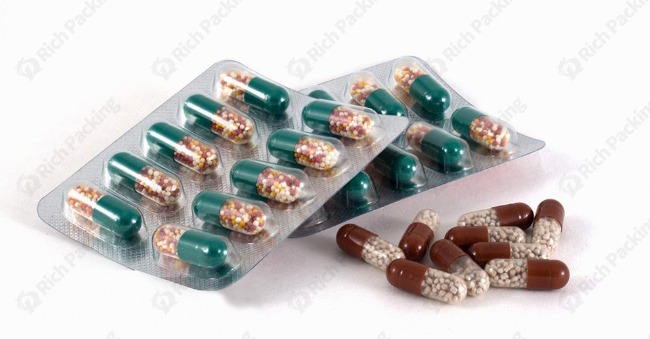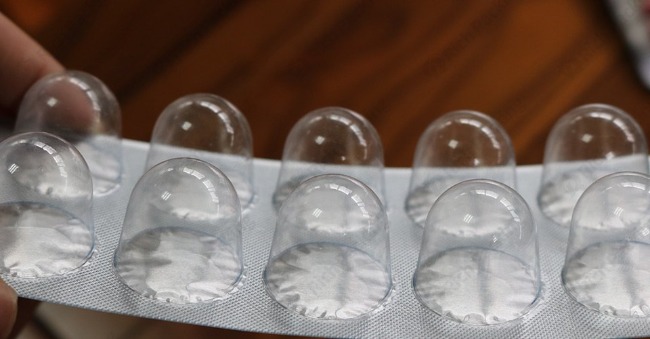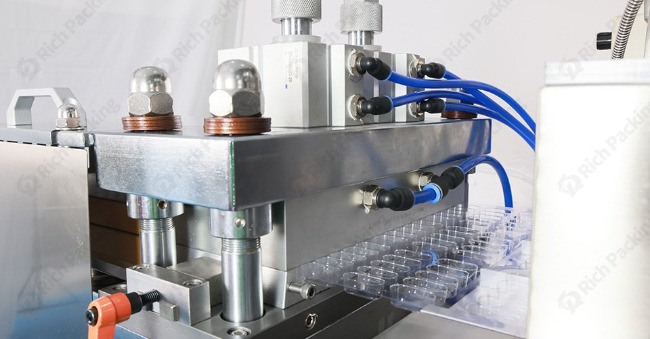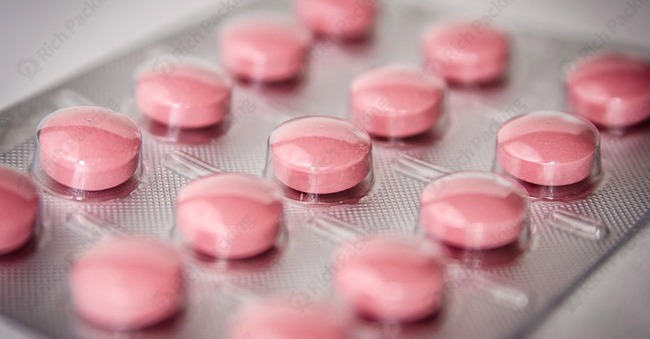Máy đóng gói vỉ nhiệt định hình đóng vai trò then chốt trong sản xuất dược phẩm. Những máy này sử dụng quy trình đóng gói nhiệt định hình để tạo ra bao bì an toàn, chính xác và đẹp mắt cho viên nén, viên nang và các sản phẩm khác.
Nếu bạn mới bước vào thế giới ép nhiệt, hướng dẫn này sẽ hướng dẫn bạn các yếu tố thiết yếu của những máy này, bao gồm cách thức hoạt động, ưu điểm và lý do tại sao chúng không thể thiếu trong hoạt động dược phẩm.

Đóng gói vỉ nhiệt định hình là phương pháp đúc các tấm nhựa thành các khoang chứa các sản phẩm dược phẩm riêng lẻ. Quy trình này bao gồm việc nung nóng nhựa, định hình thành khuôn và niêm phong bằng vật liệu nền như giấy bạc.
1. Sưởi ấm :Tấm nhựa được nung nóng cho đến khi trở nên mềm dẻo.
2. Hình thành : Khuôn hoặc khuôn đúc được sử dụng để định hình nhựa đã được nung nóng thành các khoang rỗng.
3. Làm đầy : Viên nén, viên nang hoặc các vật dụng khác được đặt vào trong các khoang.
4. Niêm phong : Một vật liệu bảo vệ được sử dụng để đóng kín các khoang một cách an toàn.
Phương pháp này đảm bảo sản phẩm an toàn, chính xác và tuân thủ các tiêu chuẩn dược phẩm.

Hiểu được các thành phần chính của những chiếc máy này sẽ giúp bạn nắm được cách thức hoạt động của quy trình đóng gói nhiệt.
Hệ thống gia nhiệt làm nóng đều tấm nhựa, chuẩn bị cho quá trình đúc. Việc kiểm soát nhiệt độ phù hợp là điều cần thiết để tạo ra các khoang rỗng đồng đều.
Đây chính là nơi phép thuật xảy ra. Trạm định hình sử dụng chân không hoặc áp suất để định hình nhựa đã được nung nóng thành các khoang phù hợp với kích thước của sản phẩm.
Các sản phẩm như viên nén hoặc viên nang được tự động đưa vào các khoang đã tạo hình bằng hệ thống phân phối chính xác.
Một lớp giấy bạc hoặc bìa cứng được dán kín vào tấm nhựa, tạo thành một bao bì kín khí và chống giả mạo.
|
Thành phần |
Chức năng |
|
Hệ thống sưởi ấm |
Chuẩn bị nhựa để tạo hình |
|
Trạm hình thành |
Định hình nhựa thành các khoang rỗng |
|
Trạm xăng |
Đặt sản phẩm vào các khoang đã hình thành |
|
Trạm niêm phong |
Áp dụng vật liệu bảo vệ nền |
Quy trình đóng gói nhiệt dẻo mang lại nhiều lợi thế, khiến nó trở thành lựa chọn hàng đầu trong sản xuất dược phẩm.
Ép nhiệt tạo ra lớp niêm phong kín khí và chống phá hoại, bảo vệ sản phẩm khỏi độ ẩm, ô nhiễm và hư hỏng vật lý.
Mỗi khoang chứa một liều duy nhất, đảm bảo chia liều chính xác và giảm thiểu nguy cơ dùng quá liều hoặc thiếu liều.
Mặc dù khoản đầu tư ban đầu vào máy ép nhiệt có thể cao, nhưng lợi ích tiết kiệm lâu dài từ việc giảm thiểu lãng phí vật liệu và sản xuất nhanh hơn sẽ lớn hơn chi phí.
Quá trình này cho phép tùy chỉnh hình dạng và kích thước khoang, đáp ứng nhiều loại sản phẩm và nhu cầu xây dựng thương hiệu khác nhau.

Máy đóng gói vỉ nhiệt định hình rất đa năng và được sử dụng rộng rãi trong ngành dược phẩm.
Những máy này lý tưởng để đóng gói các dạng bào chế rắn, đảm bảo định lượng và bảo vệ chính xác.
Đối với các thử nghiệm lâm sàng, bao bì ép nhiệt giúp đơn giản hóa việc theo dõi liều lượng và đảm bảo tuân thủ các giao thức nghiên cứu.
Các chất bổ sung như vitamin và viên nang thảo dược được hưởng lợi từ bao bì hấp dẫn và bảo vệ mà quy trình này mang lại.
Các dụng cụ y tế nhỏ, chẳng hạn như ống tiêm và que thử chẩn đoán, cũng được đóng gói bằng máy ép nhiệt để tăng thêm độ an toàn và tiện lợi.

Cả phương pháp ép nhiệt và ép nguội đều phổ biến trong ngành dược phẩm, nhưng chúng đáp ứng những nhu cầu khác nhau.
|
Tính năng |
Ép nhiệt |
Tạo hình nguội |
|
Vật liệu được sử dụng |
Nhựa |
Nhôm |
|
Tính minh bạch |
Đúng |
KHÔNG |
|
Bảo vệ rào cản |
Vừa phải |
Cao |
|
Tốc độ |
Nhanh hơn |
Chậm hơn |
|
Trị giá |
Chi phí ban đầu thấp hơn |
Chi phí ban đầu cao hơn |
Phương pháp ép nhiệt được ưa chuộng đối với các sản phẩm cần có khả năng hiển thị, trong khi phương pháp ép nguội được sử dụng cho các sản phẩm có độ nhạy cao cần được bảo vệ tối đa.
Vệ sinh và kiểm tra hệ thống gia nhiệt, khuôn mẫu và các bộ phận bịt kín để đảm bảo hiệu suất tối ưu.
Việc gia nhiệt liên tục là rất quan trọng để tạo khoang đồng đều. Luôn kiểm tra xem máy có duy trì nhiệt độ chính xác trong quá trình vận hành hay không.
Tấm nhựa cao cấp và lá nhôm cải thiện độ bền và vẻ ngoài của vỉ thuốc của bạn.
Đảm bảo rằng người vận hành được đào tạo bài bản về cài đặt máy và xử lý sự cố để giảm thiểu lỗi và thời gian chết.
Máy ép nhiệt ngày nay có nhiều tính năng tiên tiến giúp tăng hiệu quả và khả năng sử dụng.
Giao diện thân thiện với người dùng giúp đơn giản hóa việc điều chỉnh và cung cấp khả năng giám sát hiệu suất theo thời gian thực.
Máy móc hiện đại có thể sản xuất tới 600 vỉ mỗi phút, đáp ứng nhu cầu sản xuất quy mô lớn.
Cảm biến theo dõi các thông số quan trọng, chẳng hạn như nhiệt độ và kích thước khoang, để đảm bảo chất lượng đồng nhất.
Việc lựa chọn máy móc phù hợp là rất quan trọng để tối đa hóa hiệu quả và đạt được mục tiêu sản xuất.
· Khối lượng sản xuất : Đảm bảo máy đáp ứng được yêu cầu đầu ra của bạn.
· Khả năng tương thích vật liệu : Chọn máy được thiết kế phù hợp với loại nhựa hoặc giấy bạc mà bạn định sử dụng.
· Nhu cầu tùy chỉnh : Tìm kiếm thiết bị có thể chứa nhiều kích thước và hình dạng khoang khác nhau.
Nếu bạn đang tìm kiếm một máy đóng gói vỉ đáng tin cậy để nâng cao sản lượng của mình, Máy đóng gói vỉ DPP-180pro của Rich Packing nổi bật là sự lựa chọn hàng đầu, đặc biệt là đối với các hoạt động có quy mô vừa và nhỏ.
Nhỏ gọn và hiệu quả :Máy này được thiết kế để phù hợp với quy mô sản xuất vừa và nhỏ, đảm bảo bạn đạt được hiệu quả tối đa mà không ảnh hưởng đến không gian.
Tạo hình và niêm phong tiên tiến :DPP-180pro có cả khả năng ép nhiệt và ép nguội, mang đến cho bạn sự linh hoạt để xử lý các vật liệu và nhu cầu đóng gói khác nhau.
Cấu hình có thể tùy chỉnh : Có thể chứa nhiều loại khoang có hình dạng và vật liệu khác nhau, cho phép bạn tùy chỉnh bao bì theo yêu cầu cụ thể của sản phẩm.
Hệ thống điều khiển tự động :Được trang bị giao diện màn hình cảm ứng thân thiện với người dùng, DPP-180pro đảm bảo vận hành dễ dàng và theo dõi chính xác quá trình đóng gói.
Kiểm tra độ chính xác cao : Cảm biến tích hợp và hệ thống quan sát đảm bảo đóng gói hoàn hảo bằng cách phát hiện và sửa chữa mọi sự không nhất quán theo thời gian thực.
Quy trình đóng gói định hình nhiệt là một bước đột phá trong sản xuất dược phẩm, mang lại độ chính xác, khả năng bảo vệ và hiệu quả vượt trội. Bằng cách hiểu rõ cách thức hoạt động và lợi ích của những máy móc này, bạn có thể nâng cao năng lực sản xuất. Bạn có thắc mắc hoặc cần hỗ trợ tìm kiếm máy định hình nhiệt phù hợp? Liên hệ với chúng tôi hôm nay để tìm hiểu thêm!